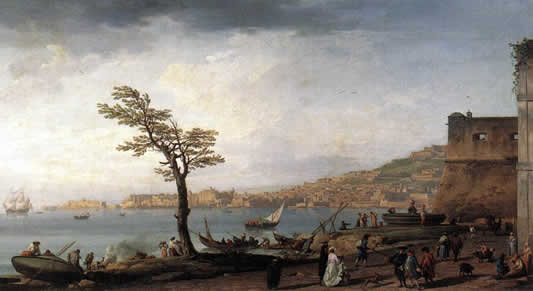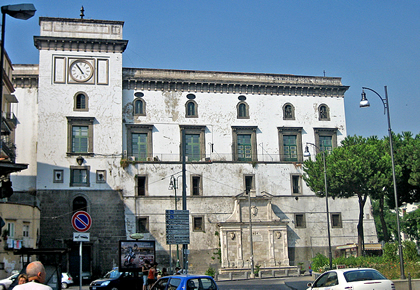 |
| The Bay of Naples |
According to myth the city of Parthenope was established in 1000–900 b.c.e., with the city of Neapolis (New City) created three centuries later nearby. The climate and beautiful location of the city had long attracted attention, with the Roman emperor Tiberius retreating to the nearby island of Capri in 27 c.e.
The former became Pompeii, which was destroyed in the eruption of Mt. Vesuvius in 79 c.e., with some of the surviving people moving to Neapolis. Although there is evidence of Christianity in Pompeii, it was not until the latter half of the fourth century that Christianity became widely accepted in Naples, with Bishop Septimius Severus building the first parish church, now San Giorgio Maggiore, in 500.
In 536 the Byzantine general Belisarius managed to capture the city of Naples after leading his army through the aqueduct, and in 553 Naples officially became a part of the Eastern Roman (Byzantine) Empire. Over the next few centuries the city survived attacks by the Goths and the Lombards; the latter laid siege to it in 600.
  |
As Byzantine control in the region waned in 763, Naples became an independent and hereditary duchy, nominally under Byzantine rule. It then sustained a number of attacks by the Saracens, who, in 902, were heavily defeated at the Battle of Garigliano.
In 1139 to gain better protection from the Turks, the people of Naples handed control of their city—and hence the protection of it—to Roger II, the Norman king of Sicily.
Naples was the first of the southern duchies to receive Roger and cheered him as he entered the city. His successor, William I (r. 1154–66), was very different. He fortified the city and started work on the construction of Castle Capuano in 1165.
This not only was where the military garrison were based, but also became a royal residence for the subsequent rulers of Naples until the mid-16th century. William however had been brought up by Arabs and established his own harem and eunuch guards, which offended many people, earning him the title of “William the Bad.”
 |
| Castle Capuano |
His successor, William II, by contrast, gained the title “William the Good” and reigned until 1189. A succession crisis followed, and the local barons chose Tancred, an illegitimate son of William II’s brother.
However Henry VI Hohenstaufen, the son-in-law of Roger II, and the Holy Roman Emperor, decided to take the city and on his second attempt captured it, executing many of Tancred’s supporters. He then established Naples as his base from 1194.
Frederick II founded the University of Naples in 1224, and 42 years later Charles I of Anjou took control of the city, making it the capital of his Angevin kingdom. In 1282 the Angevins lost control of Sicily but retained Naples. His son Charles II succeeded him, and then the throne went to Robert.
   |
In normal circumstances the throne should have passed to Robert’s older brother, Louis of Anjou (1274–97). However Louis, who had spent seven years in captivity in Barcelona as a hostage, gave up his right to the throne to take monastic vows as a Franciscan, wanting to spend his life doing good works.
He became the archbishop of Toulouse but died six months later. During that time, and in his earlier church career, he had earned such respect that in 1317 he was canonized as Saint Louis of Toulouse.
Robert died in 1343 and was succeeded by his granddaughter, the 17-year-old Joanna, who became Queen Joan I. She married four times, probably murdered one of her husbands, and was deposed and murdered in 1382 by her second cousin, Charles I, king of Hungary, who became Charles III of Naples.
The university and other places of learning in Naples, as well as the flamboyant court, attracted many great artists and thinkers, including the writer Giovanni Boccaccio, who visited the city.
The poet and humanist Petrarch visited Naples in 1343 and stayed at San Lorenzo, returning two years later. All of this laid a foundation for the great cultural center that the city was to become in the next 200 years.
In 1386 Charles III’s son Ladislas succeeded him, then died childless in 1414. He was succeeded by his sister Joanna—Joan II, who had a terrible reputation. In 1421 Joan II, who had no children, named Alfonso V of Aragon in Spain as her successor.
However before she died in 1435, she had changed her will to leave the city to René of Anjou, in whose name the city government acted until 1442, when Alfonso of Aragon came to Naples to take over the city in line with Joan’s earlier will.
René of Anjou offered to face Alfonso in single combat but the Aragonese replied that he would not risk his life for something that he would get anyway. He led his soldiers through an aqueduct and easily took the city. Alfonso V of Aragon then became Alfonso I of Naples, ruling until his death in 1458.
After the fall of Constantinople in 1453, Alfonso V encouraged many refugees to settle in the city, and Lorenzo de’ Medici visited Naples in 1479–80. In 1456 an earthquake shook the city, damaging many old buildings. In 1496, threatened by the French and the Spanish, the king of Naples ceded the city to the French but remained as its ruler until the end of the Aragonese dynasty in 1516.